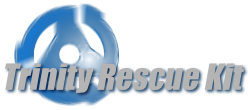Well, finally I ‘ve started work for TRK 2.0. Yes yes, 2.0 because it ‘ll be a major version upgrade with big changes and new features.
Here ‘s how I ‘m going to be working:
1) Binary upgrade to Mandrake 9.2 binaries => ongoing, my VMWare Mandrake machine has been upgraded, I ‘ve searched all other packages for their latest version. Will maybe release an intermediate version with already some new tools.
2) Choice of kernel: 2.6 or still 2.4? I ‘ll probably go for the “old” 2.4.22 Mandrake sources, unless somebody can give me a very good reason to already go to 2.6
3) Use of ISOLinux instead of Lilo as bootloader, change from 2.88mb floppy emulation to no-emu mode. This will give me the ability to have multiple bootimages not limited by 2.88mb, so I ‘ll probably be supporting MOST existing hardware from kernel, including most SCSI controllers, serial ATA and most ethernet cards (the latter still as module). Maybe add a free Caldera DOS with some free Dostools too.
4) Boot option: SSH server. Default it will try to get an address over DHCP, show it onscreen and prompt for a root-password change before starting the SSH server, this for security reasons. Customized versions of TRK can get a fix IP and password. More info below
5) Full NTFS read/write support using the Captive project (see http://www.jankratochvil.net/project/captive/ ) => this will enable decent virus scans and cleans.
6) Other new features: framebuffer mode, diskdrake, a text webbrowser like Links or Lynx, netcat, tcpdump, Active Partition recovery, shred, support for Sony Vaio, more Linux FS recovery tools, hardware testing utils, multilanguage (unicode) support.
7) Bugs to fix:
-many IBM machines don ‘t boot, with ISOLinux I hope they will.
-winpass script only checked for uppercase Windows systemdirs, but on FAT32 they appear lowercase => check all rootdirs now
-some Toshibas don ‘t boot
-…
I hope I ‘ll get most of this done before I start my new job, since this will occupy me completely.
Now, about the SSH server. Why a SSH server? Well, this can give an experienced person the ability to fix problems on a dead machine by remote, needing a regular user to be physically there and do some basic handling, like inserting TRK CD, selecting the right option and enter a password. This way, I could even fix my dad’s computer from home.
I ‘m also planning of creating custom versions at a small fee that are machine specific, meaning with a fix IP configuration for use on f.i. collocated webservers where you could login to your dead server after the serverroom guy has inserted TRK. You fix whatever ‘s wrong with your machine, cough out TRK and reboot.
Let ‘s see what the future brings..

Leave A Comment